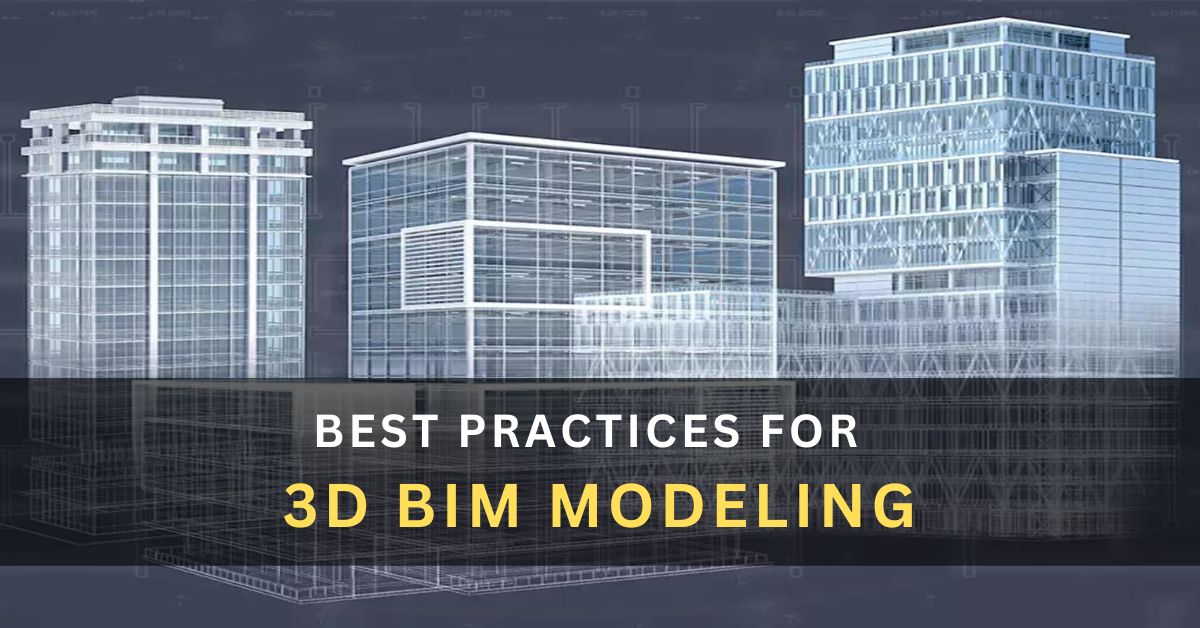
Precision in BIM: Best Practices for 3D BIM Modeling
Building Information Modeling (BIM) stands out as a revolutionary approach in the ever-evolving realm of construction and design, providing unparalleled precision and efficiency in project execution.
3D BIM modeling is the foundation of building information modeling that uses the development of Revit models in Architectural, Structural, and MEP disciplines. Revit models are populated with design information such as dimensions, material specifications, names, tags, etc.
AEC professionals must follow best practices for 3d bim modeling to ensure the development of precise BIM models for cost estimation, site planning, and facilities management.
We understand the critical role of precision in BIM, and we’re here to guide you through the best practices for 3D BIM Modeling that will elevate your projects and help you stay ahead of the curve.
Understanding the Essence of 3D BIM Modeling
Before delving into the best practices, let’s clearly understand what 3D BIM modeling entails. At its core, 3D BIM modeling is a collaborative process integrating geometry and data to create a comprehensive digital representation of a building or infrastructure.
Project stakeholders from different disciplines, such as Architecture, Structure, and MEP, develop information models using software such as Revit. These are commonly known as BIM models. These BIM models are the foundation for further activities such as 4D scheduling, 5D cost estimation, clash detection, and 6D Facilities Management.
This dynamic approach enables stakeholders to visualize, simulate, and analyze every aspect of a project, fostering efficient decision-making and reducing costly errors.
Best Practices for Achieving Precision
1. Collaboration is Key
Effective communication and collaboration are non-negotiable in the collaborative landscape of construction projects. We emphasize the importance of interdisciplinary collaboration from the project’s inception for 3d bim services. This ensures all stakeholders are on the same page, contributing to a seamless integration of ideas and expertise.
2. Regular Model Audits for Quality Assurance
Maintaining precision requires a proactive approach. We recommend regular audits of the BIM model to identify and rectify discrepancies promptly. This quality assurance measure upholds the model’s integrity and prevents potential issues.
3. Accurate Geometry for Realistic Visualization
Precision is paramount in 3D BIM modeling or 3d bim services. We advocate for employing cutting-edge tools and techniques to ensure accurate geometry. This enhances the realism of visualizations and lays a solid foundation for accurate simulations and analyses, empowering project teams with the necessary insights.
4. Data Accuracy for Informed Decision-Making
Precision goes beyond visual appeal; it extends to the accuracy of data embedded within the model.
We recommend meticulous attention to detail when inputting information into the BIM model. This precision ensures that every decision based on the model is well-informed, contributing to the project’s overall success.
More: Innovate and Visualize with 3D BIM Services
The Future of Precision in BIM
AEC companies in developed countries such as the USA, UAE, UK, Germany, and many other European countries actively use BIM for design precision, collaboration, accurate cost estimation, and project management.
BIM ensures streamlined design development with significant cooperation between project participants.
The future of BIM modeling seems very promising in developing countries such as India and Egypt. Party developers or real estate companies in these developing countries can use BIM to assess a project’s return on investment (ROI).
BIM modeling has excellent potential for design professionals such as architects and engineers. They can use their 3D BIM models to assess their design ideas and how the building would function in the real world.
We also foresee the integration of Artificial Intelligence (AI) and Machine Learning (ML), further enhancing accuracy and efficiency in 3D BIM modeling.
Conclusion
In the dynamic world of construction and design, precision in 3D BIM modeling is not just a preference; it’s a necessity.
Following the best practices for BIM modeling, AEC professionals and real estate companies can ensure superior project planning and development of detailed BIM models.
While the future of BIM seems promising for designers and real estate developers, AEC professionals must consider the integration of artificial intelligence and machine learning to enhance accuracy and efficiency in 3D BIM modeling further.
Frequently Asked Questions – FAQ
What is BIM, and why is precision crucial in its modeling?
Precision in BIM, or Building Information Modeling, is vital for creating accurate digital representations of structures. It ensures that the geometry and data within the model are highly detailed, facilitating realistic visualizations and informed decision-making.
How does accurate geometry contribute to 3D BIM Services?
Accurate geometry is fundamental in 3D BIM Services as it enhances the realism of visualizations. It provides a solid foundation for simulations and analyses, empowering project teams with precise insights.
Why is collaboration emphasized as a best practice in 3D BIM modeling in USA?
Collaboration is critical in 3D BIM modeling in USA to foster effective communication among stakeholders. Interdisciplinary collaboration ensures that diverse expertise contributes to the model, seamlessly integrating ideas and insights.
What role does data accuracy play in the success of a BIM modeling project in USA?
Data accuracy is critical in 3D BIM modeling projects in the USA as it ensures that decisions based on the model are well-informed. Meticulous attention to detail when inputting information contributes to the project’s overall success.
How can regular model audits benefit the quality of a BIM model?
Regular model audits are essential for quality assurance in BIM modeling. They help identify and rectify discrepancies promptly, maintaining the model’s integrity and preventing potential issues in the project’s execution.
What are the future trends in precision for 3D BIM modeling in USA?
The future of precision in 3D BIM modeling in USA involves the integration of Artificial Intelligence (AI) and Machine Learning (ML). These technologies are expected to further enhance accuracy and efficiency in the modeling process.
Why is 3D BIM Services considered a collaborative process?
3D BIM modeling is collaborative because it involves multiple stakeholders working together. This collaborative approach ensures that various perspectives contribute to the model, resulting in a comprehensive and well-rounded representation of the project.
How does precision in BIM modeling services contribute to error reduction in construction projects?
Precision in BIM modeling significantly reduces errors in construction projects. Accurate visualizations and data contribute to informed decision-making, minimizing the likelihood of costly mistakes during the construction phase.
Also Read, The Maldives Goes Child-Welcoming



